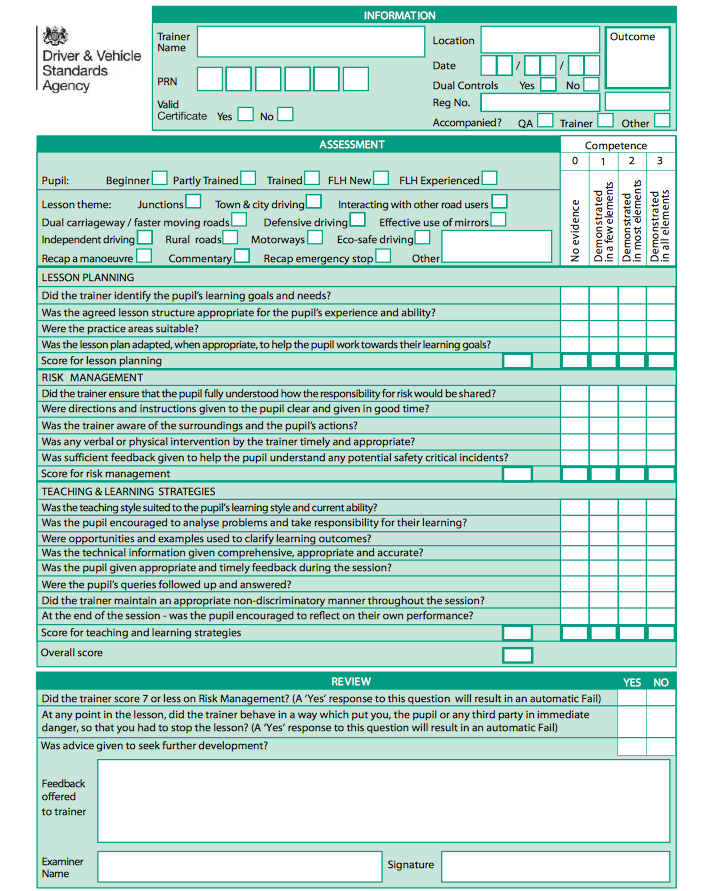DVSA Standards Check Guide and Part 3 Guide
DVSA Standards Check and Part 3 Guide
As ADI’s we all understand that it is a legal requirement of our continued registration to undergo a Standards Check (SC) at least once in the period of our four years of registration. This guide aims to help dismiss some of the apparent misconceptions and fears that have been voiced by some ADI’s about the SC process.
The aim of the SC is clearly outlined in the Examiners Guidance (ADI1) and it is to “assess the ability of the ADI to instruct and whether their instruction helps a person to learn in an effective way and will be a 40 minute lesson with 15 minutes debrief from the Examiner”. The pupil in the context of the SC can be of any ability, learner or full licence holder, but cannot be an ADI or PDI who passed the ADI part 2.
When you have received the letter inviting you to attend a SC you will be required to email back confirming your intention to attend at the appointed time and test centre. Failure to attend the SC appointment can result in your removal from the register.

The assessment is made against 3 broad or ‘high’ areas of competence:
-Lesson planning
-Risk management
-Teaching and learning strategies
The three high areas of competence are broken down further into 17 lower level competences. A mark between 0-3 will be given for each competency. These marks will be totalled to give an overall mark, with the highest total being 51.
Marks will be given as follows:
- 0 = no evidence of competence
- 1 = a few elements of competence demonstrated
- 2 = competence demonstrated in most elements
- 3 = competence demonstrated in all elements
The grading system is as follows:
· Ungraded 0 to 30
· Grade B 31 to 42
· Grade A 43 to 51
If you score 7 or less in the section marked Risk Management, the test is graded as a fail, REGARDLESS of the overall points scored.
Lesson Planning
Did the trainer identify the pupils learning goals and needs?
Was the agreed lessons structure appropriate for the pupils experience and ability?
Were the practice areas suitable?
Was the lesson plan addapted, when appropriate, to help the pupil work towards their learning goals?
Risk Management
Did the trainer ensure that the pupil fully understood how the responsability for risk would be shared?
Were directions and instructions given to the pupil clear and given in good time?
Was the trainer aware of the surroundings and the pupils actions?
Was any verbal or physical intervention by the trainer timely and appropriate?
Was syfficiant feed back given to help the pupil understand any potential safety critical incidents?
Teaching & Learning Strategies
Was the teaching style suited to the pupils learning style and current ability?
Was the pupil encouraged to analyse problems and take responsability for their learning?
Were opportunities and examples used to clarify learning outcomes?
Was the technical information given comprehensive, appopriate and accurate?
Was the pupil given appropriate and timely feedback during the session?
Were the pupils queries followed up and answered?
Did the trainer maintain an appropriate non-discriminatory mannor throughout the session?
At the end of the session - was the pupil encouraged to reflect on their own performance?
Planning & Preparation It goes without saying that preparation for taking the SC is vital
The following are pointers to aid this preparation:
- Taking care in selecting a pupil is vitally important, but we would also recommend that you line up a back up pupil, just in case your first choice of pupil is unable to attend (last minute sickness or failure to show). Try to use a pupil who is quite chatty and who will be confident in answering questions, as opposed to having someone who is quiet or lacking in confidence, as this could make the session very stilted and difficult.
- Also in your preparations it is sensible to try and stay within your comfort zone; in practice this means that if you are mostly used to teaching learners it would be sensible to plan a session with a learner.
- If you are not used to training full licence holders, we would not recommend you select this category of pupil. The reasons are obvious; full licence holders require a very different training approach, which is more a matter of involvement and working with them to find out where they are with their driving and then making suggestions as to where they could make improvements. Or to put it another way with full licence holders “we ask and suggest, we don’t tell”.
- Plan your lesson well in advance of the SC, get to know the timings and any possible route issues and/or risks.
- On the day of the test we would also recommend, well before the lesson, that you check your intended route for last minute road works and potential problems. Have an idea of alternative routes or short cuts in case you get held up in traffic. Identify places to be able to pull over to in order to discuss problems.
- Try to arrive in plenty of time, you really don’t want to be late. I personally would take the pupil into the test centre to introduce the pupil to the supervising Examiner.The Examiner will explain to the pupil what the purpose of the SC is and will then ask the pupil to go to the car and tell them that you will join them shortly.